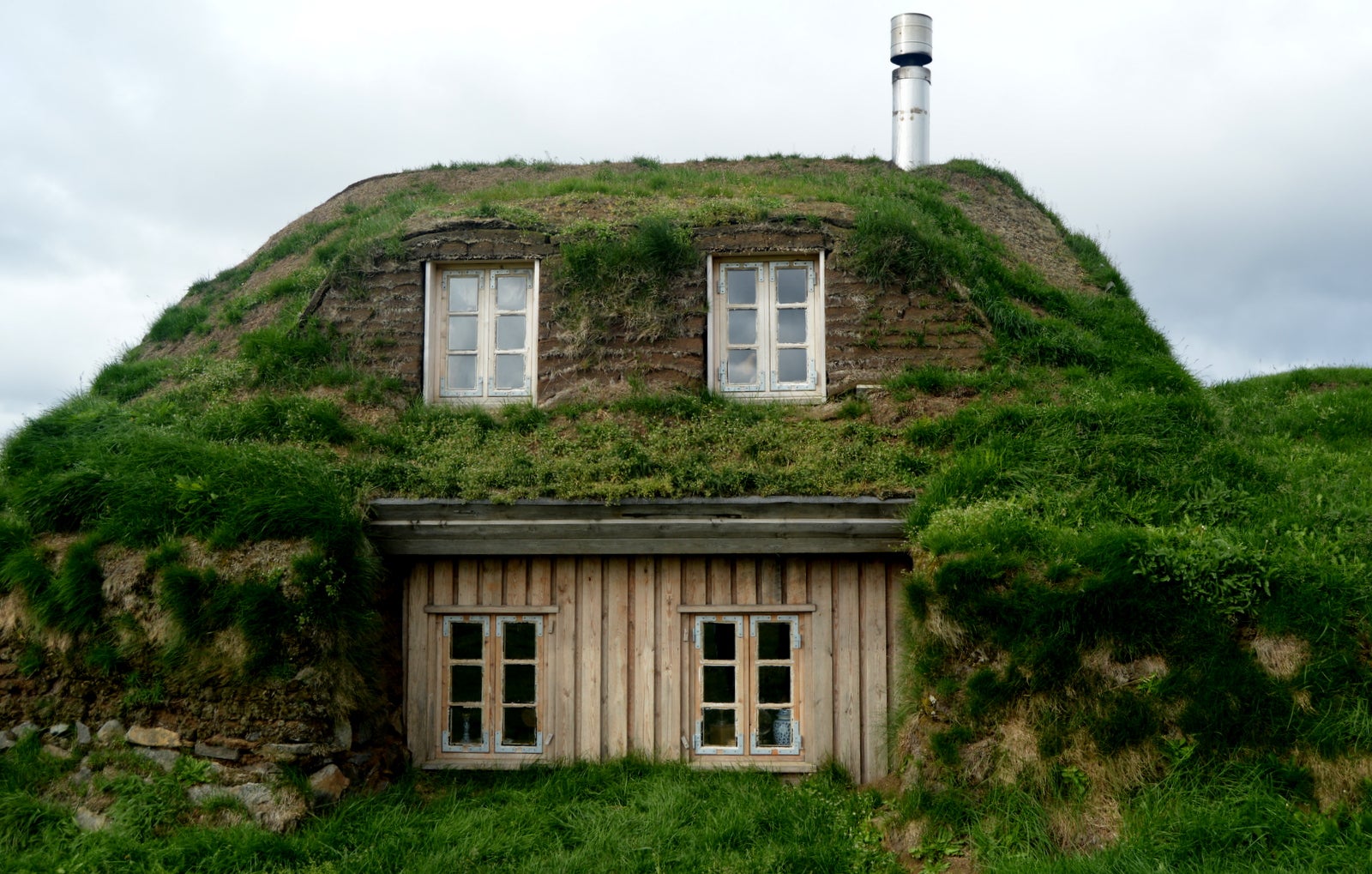
One such story tells us about the gentle troll Bergþór at Bláfell. It took place in Haukadalur valley, very close to one of the most popular tourist attractions in Iceland, the Geysir geothermal area.
Opening photo: a statue of Bergþór at Bláfell by Geysir
 Strokkur erupting at the Geysir geothermal area
Strokkur erupting at the Geysir geothermal area
If you have visited the Geysir geothermal area then you might have noticed a wooden statue of a troll.
It used to be in a prominent location with a large bench next to the troll, but it has now been moved to another location close by, and it is much less prominent now, so you might even miss it.
I always have my photo taken with Bergþór when I visit the Golden Circle, which includes the Geysir geothermal area, Gullfoss waterfall, Kerið crater, and Þingvellir national park.
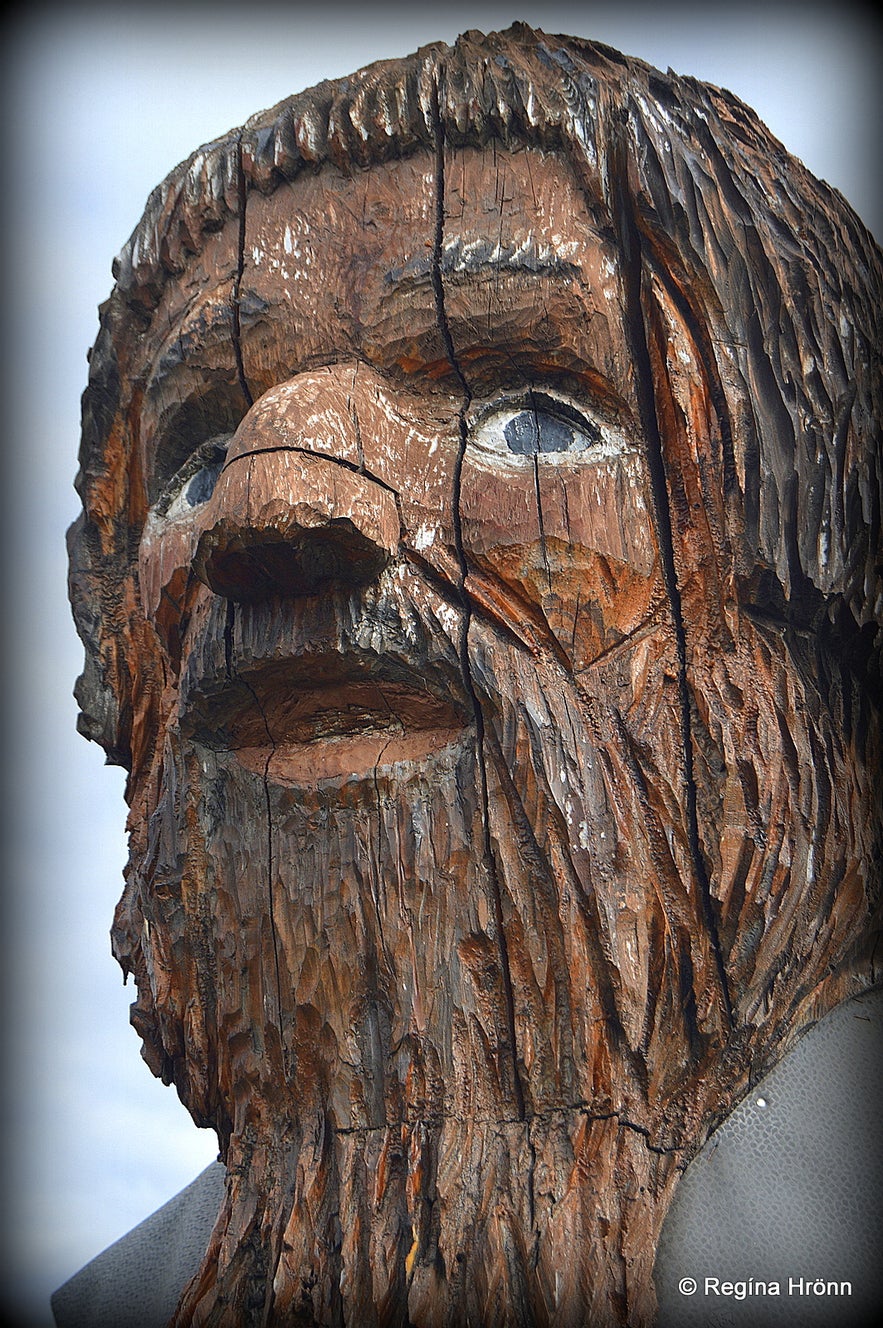
Bergþór í Bláfelli
The story of the troll Bergþór is told in Þjóðsögur Jóns Árnasonar - the Compilation of Folklore of Jón Árnason, and he is also mentioned once in the 9th chapter of Bárðar saga Snæfellsás and Ármannssaga hin yngri.
I translated the folklore into English from Þjóðsögur Jóns Árnasonar - the Compilation of Folklore of Jón Árnason, which I often refer to in my travel-blog.
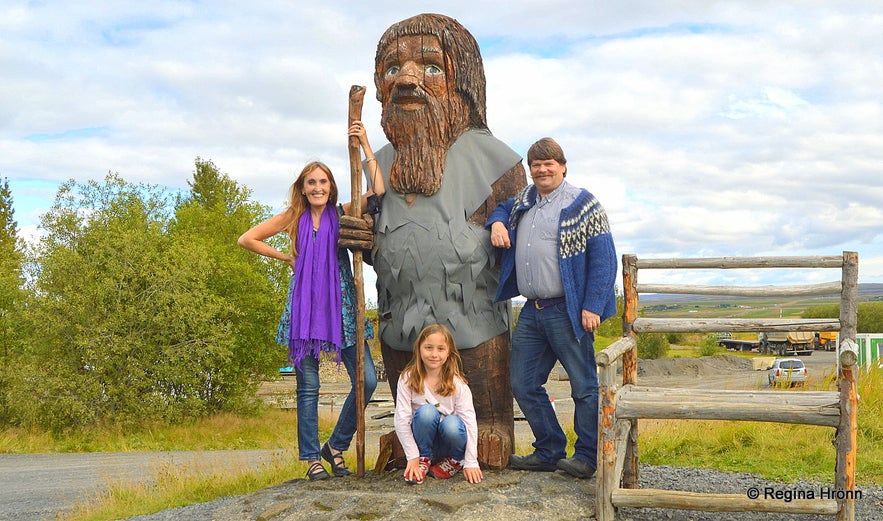
By the statue of Bergþór at Bláfell by Geysir
The story goes like this:
"A man (troll) named Bergþór lived in a cave in Mt. Bláfell; he had a wife named Hrefna. His father was Þórólfur in Mt. Þórólfsfell also called Kálfatindar, but his mother was Hlaðgerður in Hlöðkufell.
Iceland was heathen when this story happened.
At that time the giantess Hít in Hítardalur valley in West Iceland held a big troll party in Hundahellir cave.
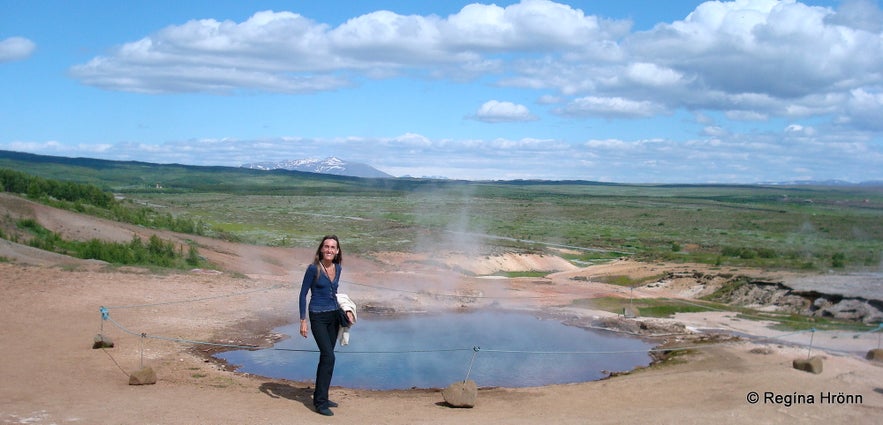 In my photo by Konungshver hot spring, you can see Mt. Bláfell in the distance
In my photo by Konungshver hot spring, you can see Mt. Bláfell in the distance
All the trolls in Iceland were invited including Bergþór.
After dinner, Hít invited the trolls to entertain themselves, and they chose tests of strength and Bergþór was amongst the strongest of men".
I told you the story about the big troll party in my travel-blog:
The Giantess Hít in Hítardalur Valley and the Party of the Trolls - Icelandic Folklore
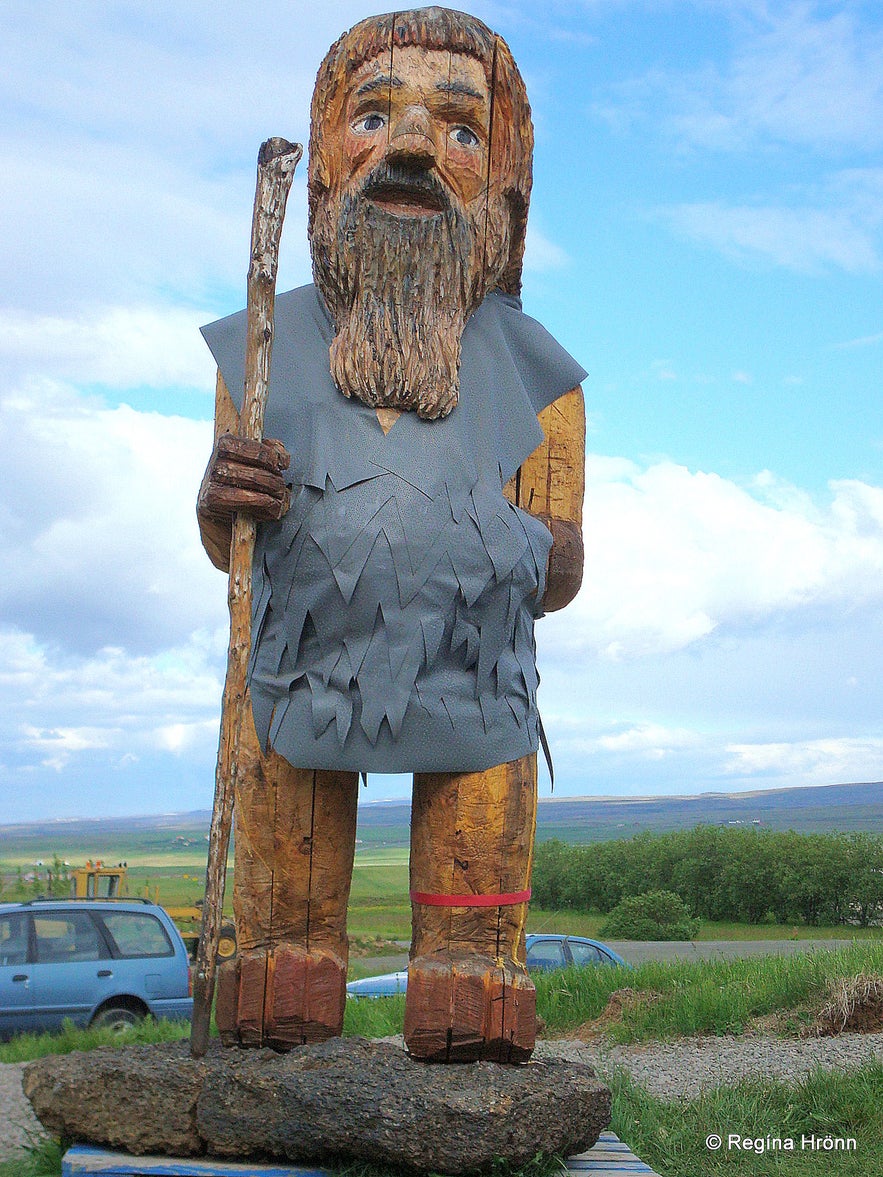 My first photo of Bergþór in the summer of 2008 - see how newly painted it was back then
My first photo of Bergþór in the summer of 2008 - see how newly painted it was back then
Bergþór was a gentle troll and didn't hurt anybody as long as he was not provoked and he was thought to be clairvoyant and wise.
When Christianity started spreading in Iceland Hrefna urged her husband to move away from Mt. Bláfell north across the Hvítá river.
She couldn't stand watching the settlement below after the inhabitants became Christians (trolls were not Christian and shunned away from everything having to do with Christianity ).
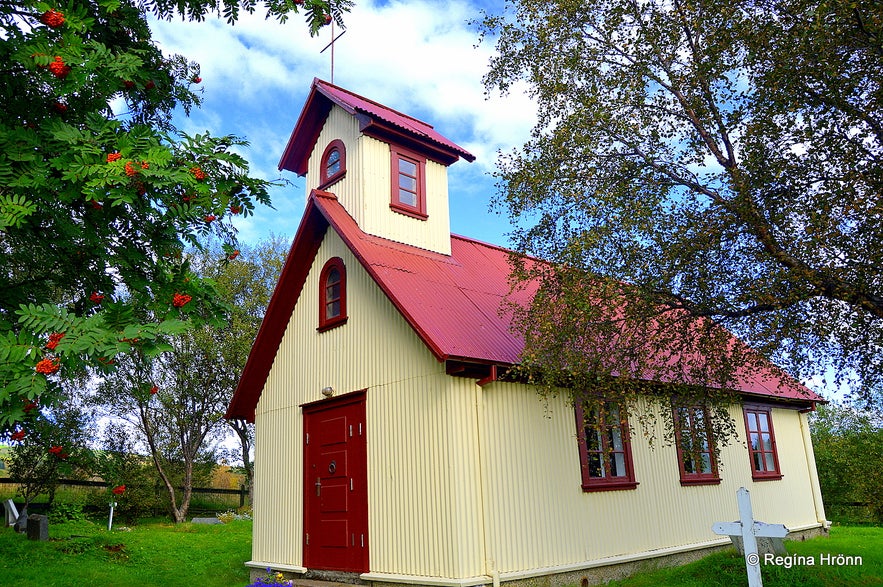 Haukadalskirkja church
Haukadalskirkja church
Bergþór didn't think this mattered at all and told Hrefna that he would stay in the cave.
Hrefna decided to move anyway and moved north of the river and built a lodge beneath a mountain; it has since been called Hrefnubúðir.
From then on the couple only met up by Lake Hvítárvatn and went trout fishing together.
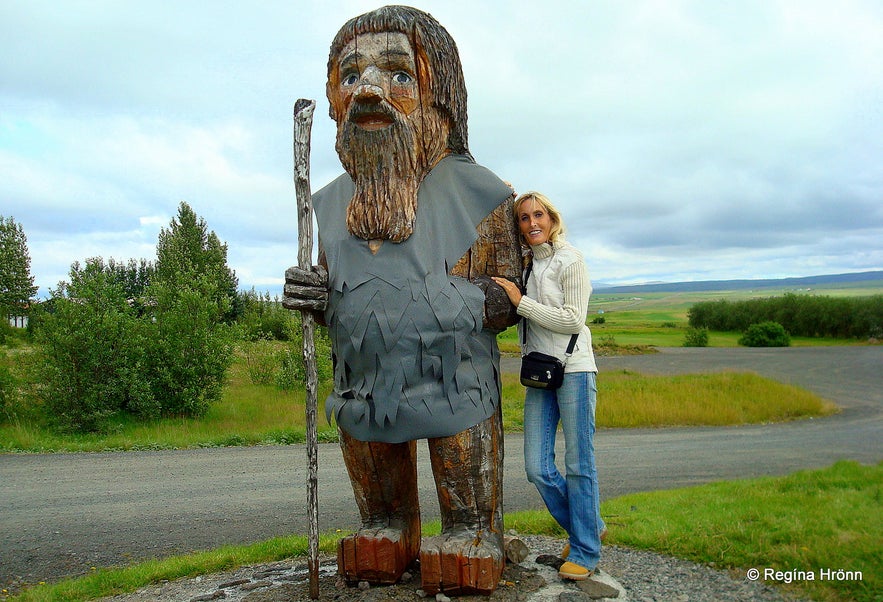 The first photo of me and Bergþór was taken in the summer of 2010
The first photo of me and Bergþór was taken in the summer of 2010
Bergþór frequently went to Eyrarbakki village to buy flour, particularly in the wintertime when there was ice on the lakes. He carried with him two barrels of flour.
When he arrived at Bergstaðir farm in Biskupstungur he met the farmer and asked him to give him something to drink. Bergþór told the farmer that he would wait while the farmer went to fetch the drink.
Bergþór put down the barrels by the rock, which the farm gets its name from - Bergstaðir - Rock farm - and sculpted a hole into the rock with the point of his staff. The farmer returned with the drink and offered it to Bergþór.
 Beiná - the Bone river runs by Haukadalskirkja church and the grave of Bergþór
Beiná - the Bone river runs by Haukadalskirkja church and the grave of Bergþór
As Bergþór had quenched his thirst he thanked the farmer and told him to use the stone tub for keeping sour whey (mysa) and mentioned that water would not mix with the whey in the stone tub and it would not freeze, but misfortune would happen if the farmer were not willing to use the stone tub.
Bergþór then said goodbye to the farmer and went on his way. (See another similar account a little bit further on in my travel-blog and there is also yet another version available which I didn't translate).
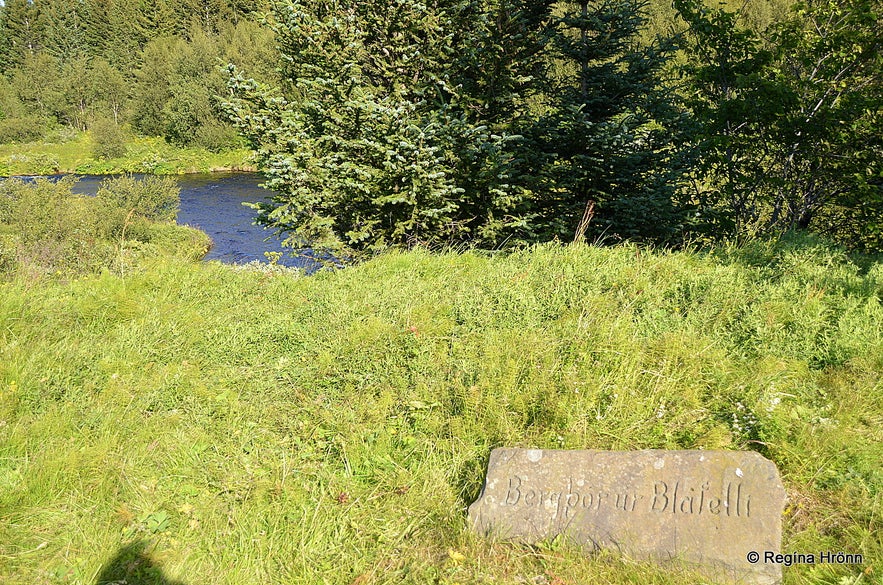 The grave of Bergþór is very close to the river - and the church
The grave of Bergþór is very close to the river - and the church
When the giant grew older he once went down to Haukadalur valley and asked the farmer at Haukadalur to secure him a grave, where the chime of the church bells could be heard and the sounds of the river which runs by Haukadalskirkja church; he asked the farmer to move his dead body to Haukadalur.
Then the farmer should go and collect his body in his cave in Mt. Bláfell and the payment for his good deed would be found inside his kettle.
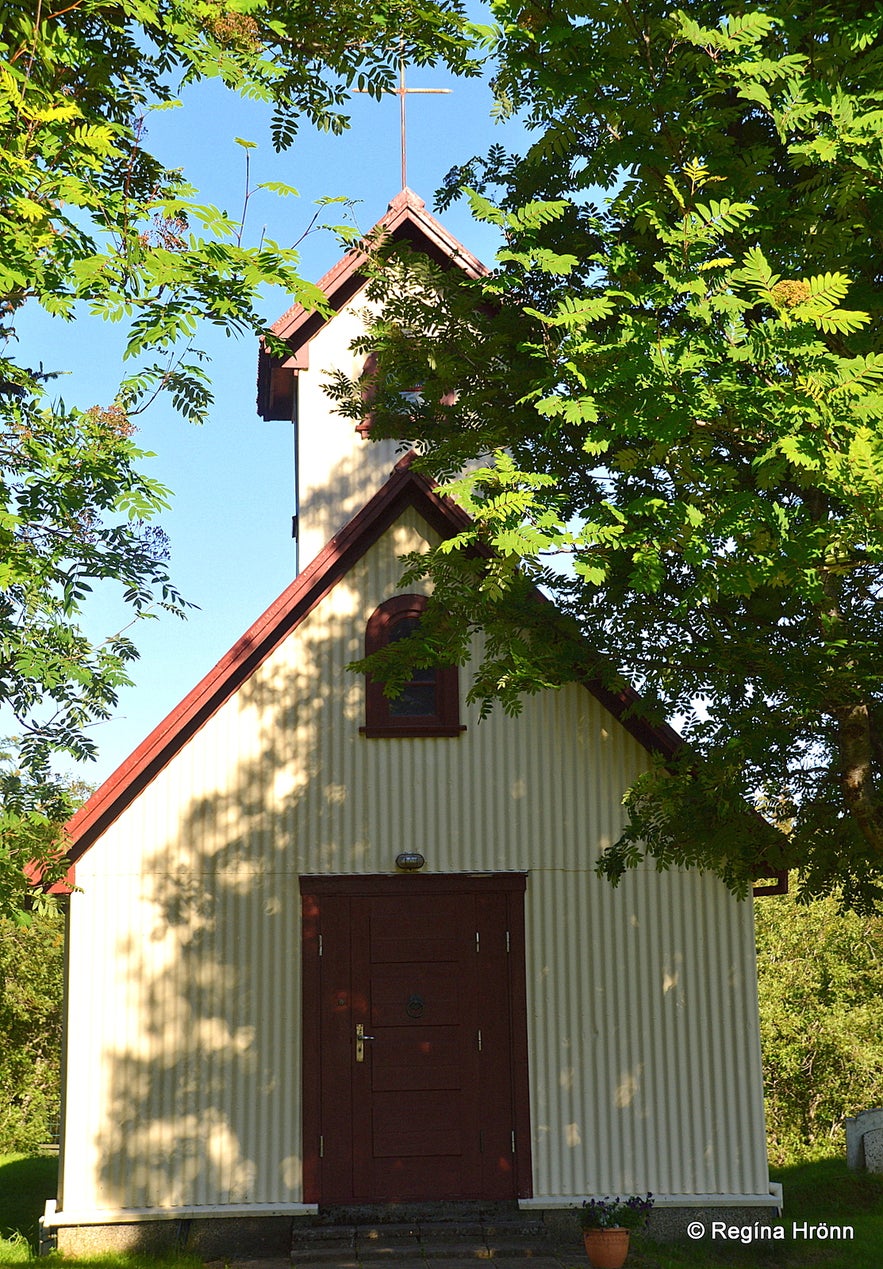 Haukadalskirkja church
Haukadalskirkja church
As a sign of his death, his large walking staff would be by the farm door in Haukadalur. The farmer agreed to this and they parted.
One morning as the country people arrived at Haukadalur they found a huge walking staff by the farm door.
The farmer was informed about this and recognized the walking staff of Bergþór.
He had a coffin made and went up to Mt. Bláfell in the company of several of his men; they found Bergþór dead in his bed in Bergþórshellir cave.
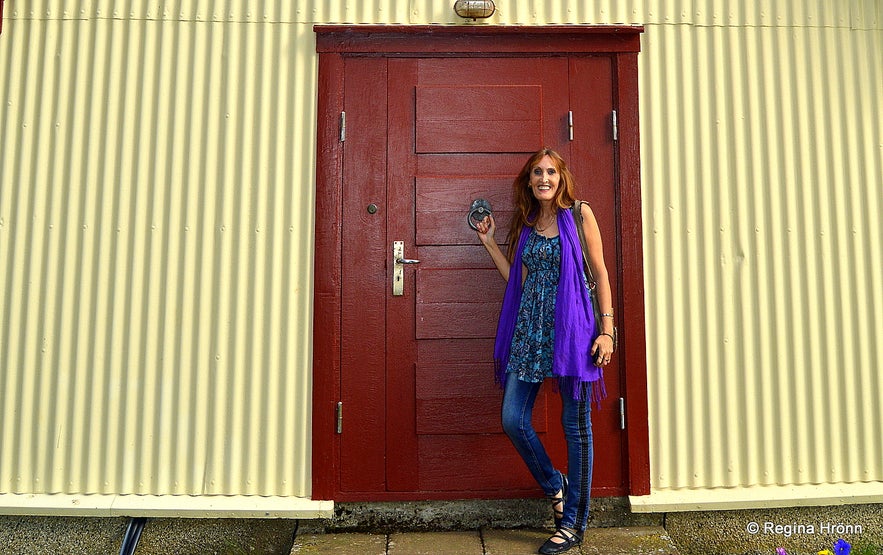 Holding onto the ring - the church was locked
Holding onto the ring - the church was locked
They placed him in his coffin and were surprised that such a huge man (troll) didn't weigh more as he seemed light to them.
The farmer noticed a big kettle by the bed and checked to see if it contained anything, and when he saw nothing but leaves inside it he gathered that Bergþór had tricked him so he left the leaves behind.
But one of the men in his group filled both his mittens with these leaves.
When they had descended from the mountain and carried the coffin to the level ground they rested and the man who had taken the leaves checked his mittens; they were filled with money!
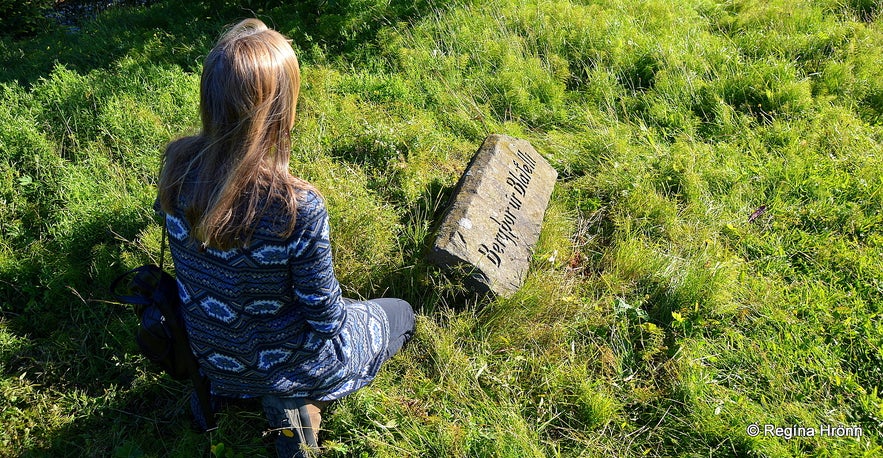
By Bergþór's gravestone
The farmer and his men returned to the cave to pick up the kettle, but they didn't find the cave and it has been hidden ever since.
(Bergþór is mentioned in one of the books of Jón lærði Guðmundsson (1574 – 1658) as being amongst those men from the early ages of Icelandic history who knew how to open and close rocks: "Þeir kunnu jörð og berg að opna og aftur að lykja, þar úr og inn að ganga, so sem að voru þeir Bárður í Jökli, Hámundur í Hámundarhelli, Bergþór í Bláfelli, Ármann í Ármannsfelli, og Skeggávaldi sem fann Áradali").
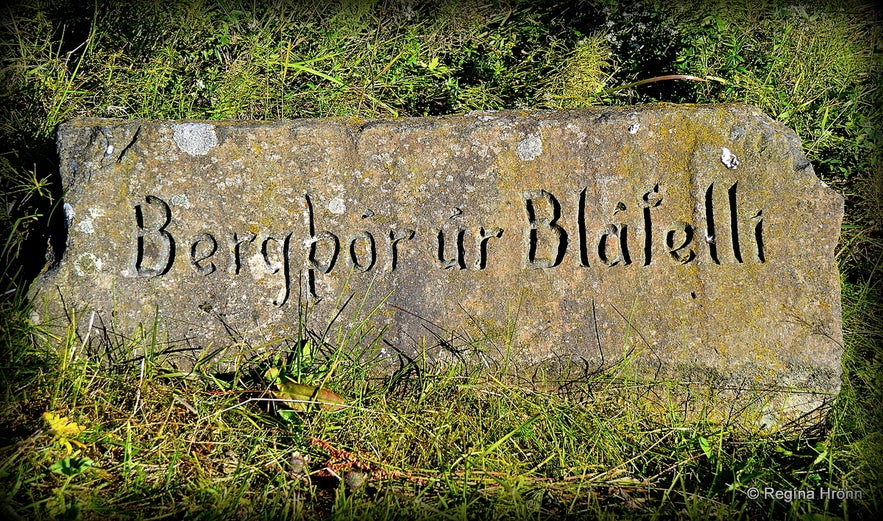
The gravestone of Bergþór úr Bláfelli
They returned and carried the body of Bergþór down to Haukadalur and the farmer had him buried north of the graveyard; it has since been called Bergþórsleiði or the Grave of Bergþór.
The ring from Bergþór's walking stick is the same ring as the one on the shield on the church door, and the spike of the walking stick is also in the possession of the church".
(I translated this folklore into English from Þjóðsögur Jóns Árnasonar - the Collection of Folklore of Jón Árnason)
 The ring on the church door
The ring on the church door
The forestry director, Hákon Bjarnason, put a gravestone, at his own expense, on the grave of Bergþór.
He also put the gravestone on the grave of Jón hrak at Skriðuklaustur in East Iceland. Bless him for doing this.
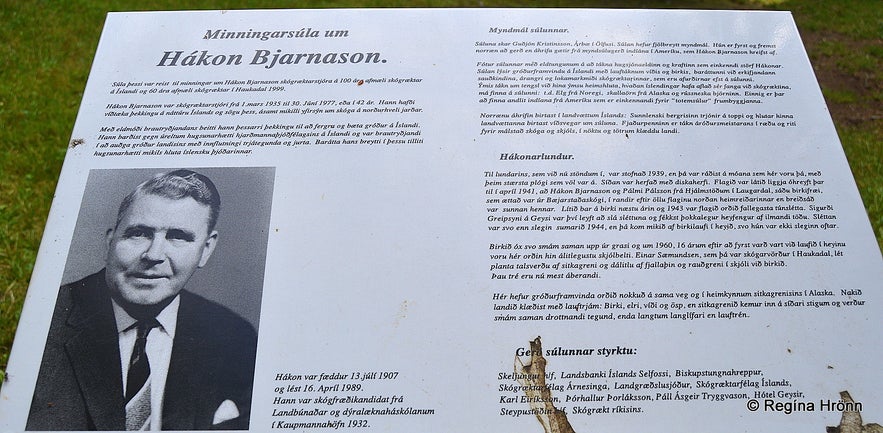 The information sign about the memorial pole for Hákon in Hákonarlundur grove
The information sign about the memorial pole for Hákon in Hákonarlundur grove
You will find Hákonarlundur grove in Haukadalsskógur forest with a carved pole in memory of Hákon Bjarnason.
I have written about the forest and the grove amongst other things in my travel-blog:
The Icelandic Haukadalsskógur Forest, Marteinshver hot spring, and a dip in Kúalaug hot pool
The carvings on the pole refer to the history of forestation in Iceland and show the land wights of Iceland, who protect the north, south, east, and west parts of Iceland.
 Landvættir Íslands - the land wights of Iceland in Hákonarlundur grove
Landvættir Íslands - the land wights of Iceland in Hákonarlundur grove
Another folklore is called Bergþór í Bláfelli. It is short and tells us the story of the stone tub, which Bergþór made at Bergstaðir. I translated it into English:
"Bergstaðir is a farm in Biskupstungur. By the farm is a tub, which has been sculpted in rock. The story goes that the giant Bergþór, who was at Mt. Bláfell, had sculpted this tub.
This stone tub was used for keeping sour whey (mysa).
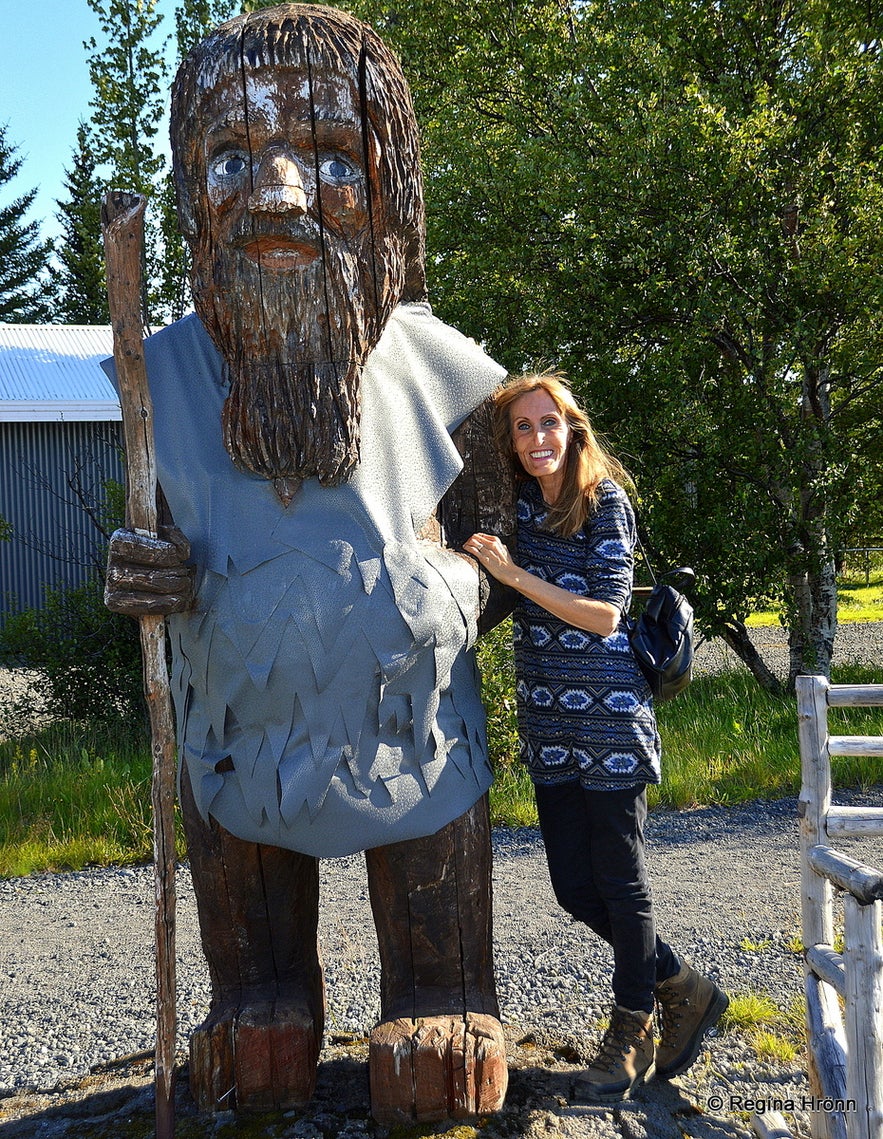
With Bergþór in his new location in the summer of 2020
Care had to be taken so that water wouldn't enter the stone tub and mix with the whey as then it would freeze. And it must never be neglected to put whey into the stone tub or else misfortune would happen to the farmer's livestock.
This has only happened thrice in the last few years. Every time this happened the farmer at Bergstaðir farm lost some of his livestock".
(Translated into English from Þjóðsögur Jóns Árnasonar - RHR)
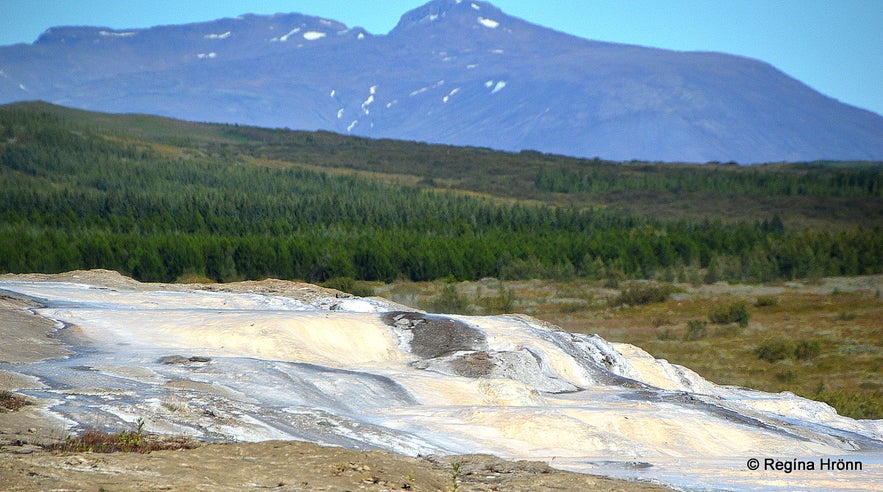 Here you can see how close, when zoomed in, Mt. Bláfell is to the Geysir geothermal area
Here you can see how close, when zoomed in, Mt. Bláfell is to the Geysir geothermal area
The owners of Bergstaðir in Biskupstungur (now Bláskógabyggð) still carry on this tradition of filling the stone tub with whey every year in August.
And, according to Sveinn Kristjánsson, who lived from 1915-1940 at Bergstaðir and often had the role of filling the stone tub with whey, it happened twice in the 26 years that he lived on this farm that the stone tub wasn't filled with whey.
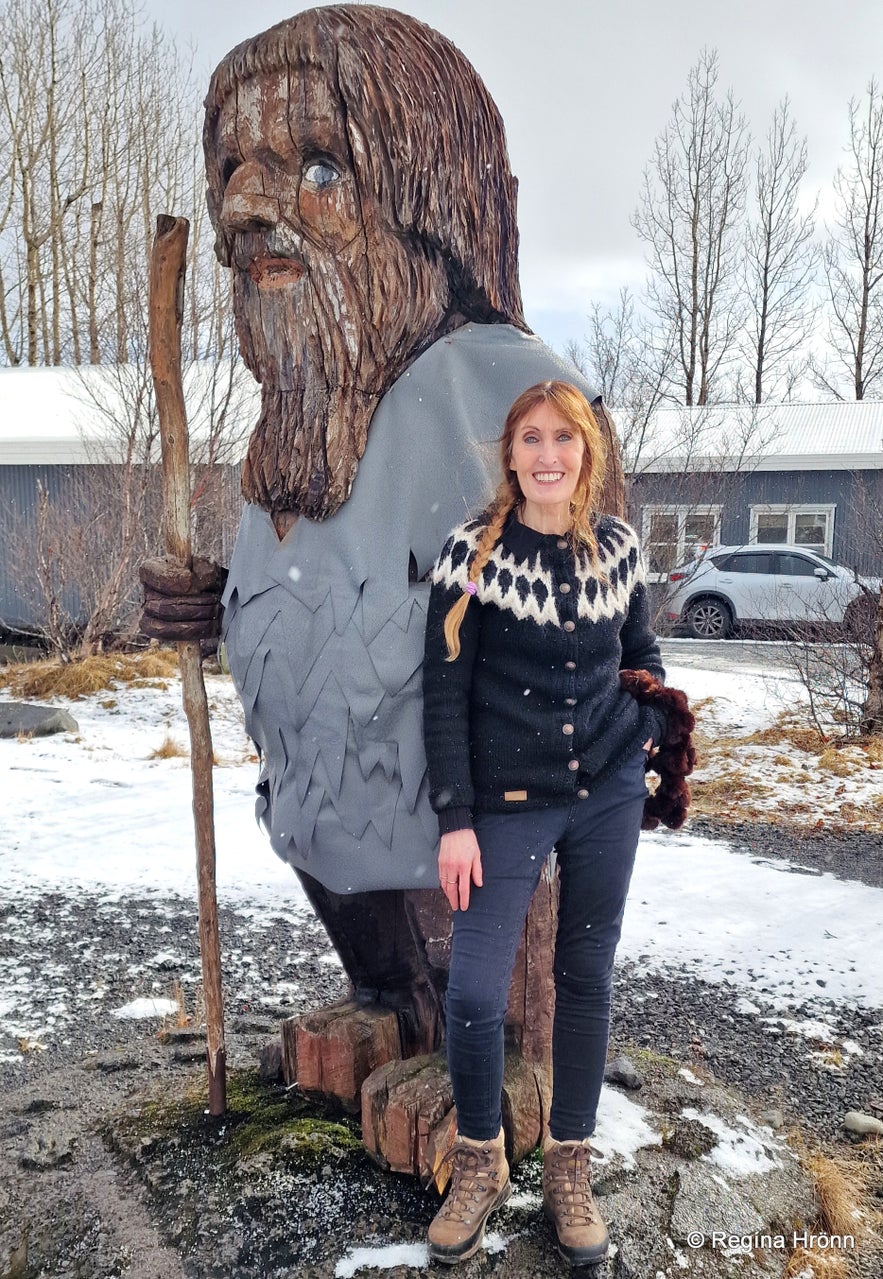 Bergþór in the winter of 2025
Bergþór in the winter of 2025
The first year a cow died (1 out of 3) and a good mare died in the marsh. In the second year that the stone tub didn't get filled with whey, 20 sheep died of lung disease.
Later on, in the last year that the farmers at Bergstaðir lived on the farm and only had 2 cows left, both of them died suddenly.
The old farmers checked if the stone tub hadn't been filled with whey and found out that it hadn't been filled for a year and a half.
So they directly connected the death of the cows to the missing whey in the stone tub.
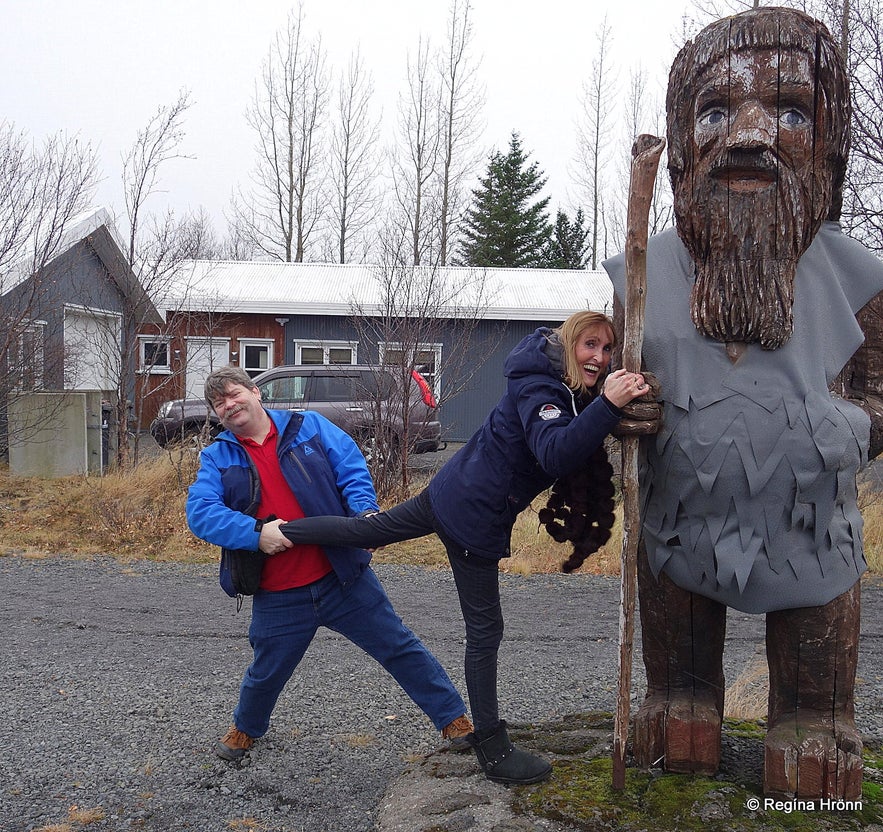 With Bergþór in the winter of 2022
With Bergþór in the winter of 2022
The story goes that some of the locals in this area, Tungnamenn, can still see Bergþór roaming around this area, drinking whey from the stone tub, and always make sure that there is enough whey for him to drink.
I must pop up to Bergstaðir (Bergsstaðir) next summer to see if I can find the stone tub and take a photo of it.
I love such folklore and hope you enjoy reading about them as well. I think they add to the experience of visiting these places.
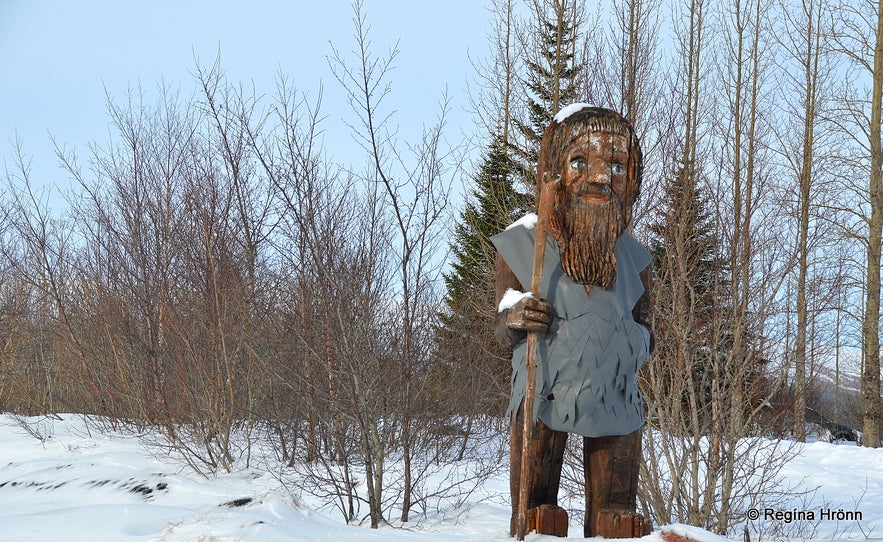 Bergþór roaming around with his walking staff
Bergþór roaming around with his walking staff
In Ármannssaga hin yngri (chapter 6) it is mentioned that Bergþórr at Bláfell was the son of Geirr in Keldudalur and Hallgerður Þórálfsdóttir. Hallgerður was the daughter of Þórálfur and Hlaðgerður, but Þórálfur plays a big role in Ármannssaga hin yngri.
In the folklore on the other hand, Bergþór is said to be the son of Þórólfur and Hlaðgerður, not their grandson.
In Ármannssaga hin yngri (chapter 10) Bergþór is mentioned in connection with the troll games at Hofmannaflöt plains, which I have told you about in another travel-blog:
Ármann in Mt. Ármannsfell and the Troll Games on Hofmannaflöt Plains in South Iceland
Bergþór was only 10 years old at the time and was defeated by Ormur sterki - Ormur the Strong in these troll games.
 Hofmannaflöt plains where the troll games took place
Hofmannaflöt plains where the troll games took place
The wooden statue of Bergþór was made in 2006 by Bjarni Þór Kristjánsson and Jón Adolf Steinólfsson. The original idea came from Guðmundur Magnússon, who wanted to make a statue with a reference to Icelandic history.
Bergþór is made from wood from Haukadalur valley and weighs around half a tonne. Why the statue was moved I don't know, but it happened when the new hotel was erected.
I love statues like this, which make Icelandic folklore and the Sagas come alive, and only wish that there would be more statues from our folklore and the Sagas in other historical locations in Iceland.
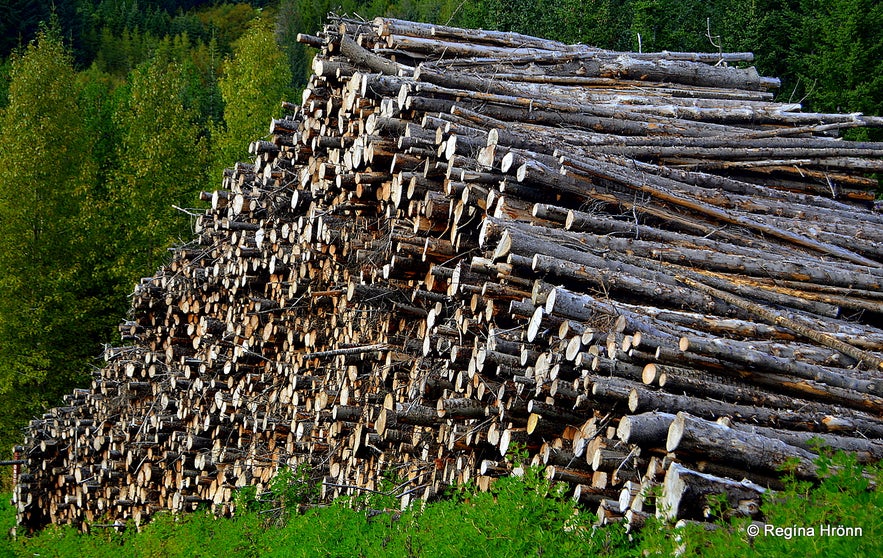 Wood from Haukadalsskógur forest
Wood from Haukadalsskógur forest
There is so much to see and do in this area, which you can read about in another travel-blog about the Geysir geothermal area which is one of the most popular attractions in Iceland:
The spectacular Geysir Geothermal Area - Strokkur and all the other Hot Springs.
And, in the vicinity is The Majestic Gullfoss - Iceland's Golden Waterfall, which gives a Name to the Golden Circle.
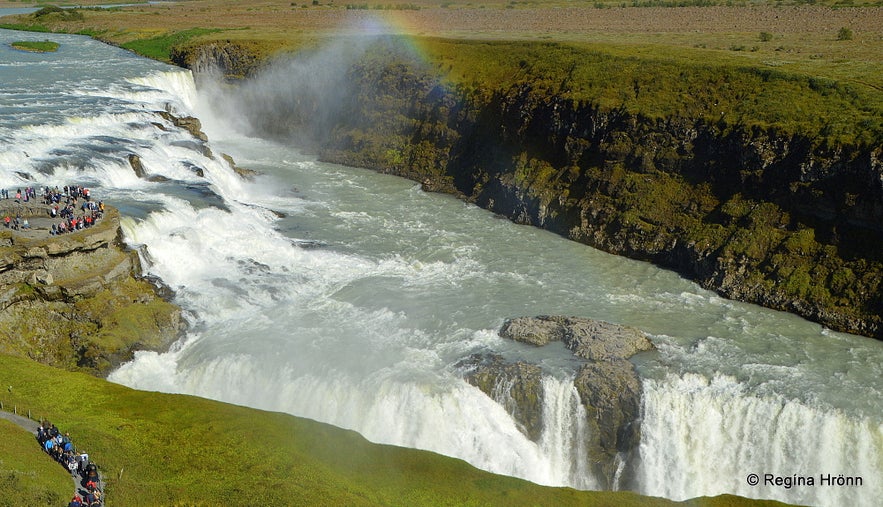 Gullfoss waterfall
Gullfoss waterfall
I have also written several other travel-blogs about trolls if you are interested in Icelandic folklore, f.ex.:
The temperamental Giantess Jóra in Jórukleif and the Lava Pots by Selfoss in South Iceland
The gentle Giantess in the Cave in Keflavík in SW-Iceland - Skessan í hellinum
Kerlingarskarð Pass in Snæfellsnes in West Iceland - the Folklore of the Giantess & her Fiancé
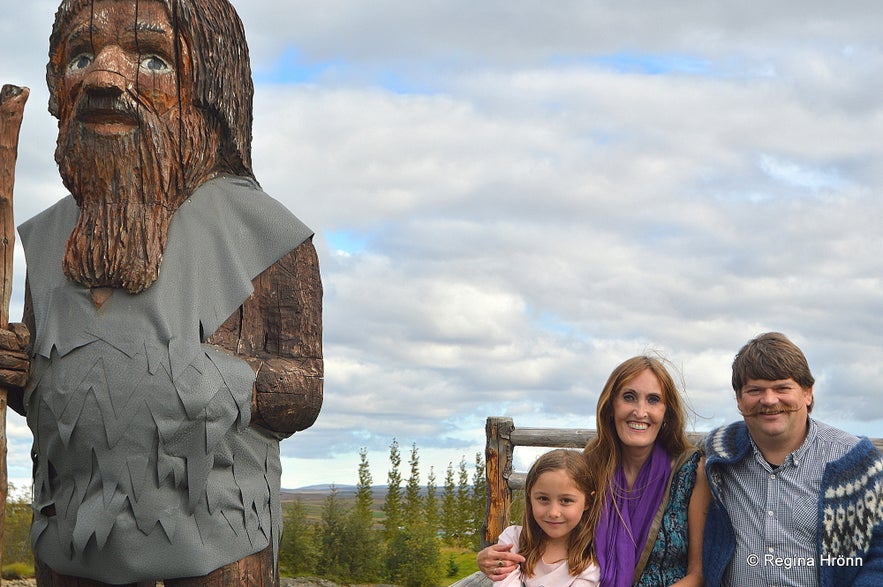 With Bergþór back in 2016
With Bergþór back in 2016
Have a lovely time in Iceland and I hope that you spot the wooden statue of Bergþór when you visit the Geysir geothermal area. If you do stop by him and greet him as now you know his story :)
Ref.
Þjóðsögur Jóns Árnasonar volume I - pages 202-203
Bergþór Bláfellingur (here Bergþór is said to be buried at Skálholt)
Heimskringla - Bergþór í Bláfelli
Að kunna jörð og berg að opna og aftur að lykja - Viðar Hreinsson



